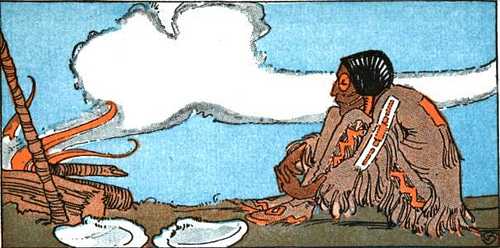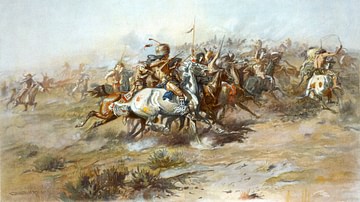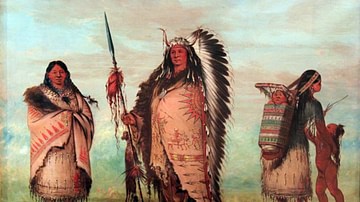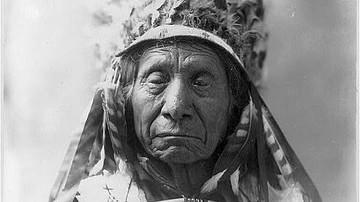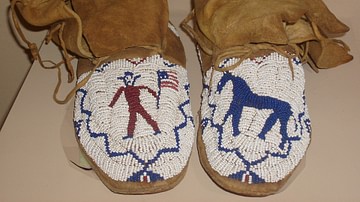The Bound Children is a Sioux legend highlighting the importance of proper behavior, not only among family members but within one's community. The widow, who does not properly care for her children, is punished, along with those who support her, while the children, and the old woman who takes them in, are rewarded.
In Sioux culture, as in Native American culture generally, the good of the community outweighed the interests of the individual. The Bound Children focuses on this theme as the widow neglects her children – and so her communal responsibility – to pursue her own interests. Although she, at first, is successful, she eventually fails when her children, with the help of the old women – and the supernatural entity of Unktomi – reveal who she truly is. In this story, unlike many others, Unktomi only serves as an intermediary but still – true to his character – acts as a catalyst for transformation.
Commentary
Even though the story does not explicitly state that the widow comes to a bad end, it is implied in the conclusion by how she is received by the daughter she abandoned (as well as earlier when she reverts to her true self in the eyes of the chief's son). The old woman who saved the widow's children is honored as their grandmother – a title of great honor – and given the choicest meat while their mother, the widow, is only given the liver, "very dry and hard to eat." The widow, even though she has managed to advance herself by marrying the chief's son, is understood as deserving of a much lower social station because of her actions.
Central to the story is the figure of Unktomi (also known as Iktomi), the trickster spirit in Sioux spiritual and cultural belief, who often appears as a spider weaving webs and can serve to help or hurt but always encourages some form of transformation. He is also depicted as a man in traditional attire but, even in this form, is still regarded as a figure one should be wary of in any encounter. Unktomi is said to have been the firstborn son of Inyan, the primordial god of rock/stone, born at the creation of the world. As such, he paradoxically counters the understanding of the stability of stone and instead symbolizes the uncertainty inherent in the act of creation. In creating anything, one can never know how it will finally turn out or eventually be received.
Unktomi, then, can be a force for the good of the one who encounters him or for ill, but, either way, Unktomi is never wholly good or evil; he just is. Whatever circumstances arise from his behavior or one's interaction with him are left to the person's or people's interpretation to deal with. In many Sioux legends, such as the famous epic White Plume (not to be confused with the story of the same title from the Blackfoot Confederacy), Unktomi is a villain but, in many others, he is a hero or, at least, lends his powers to support the greater good. In this story, Unktomi acts as an intermediary between those who have been wronged and those who committed the sin, simply bringing them together, without having to resort to any supernatural influences. At the same time, however, he still remains true to character by not telling either party that he already knows the whole story from the start.
The just behavior of the old woman, and the virtue of the abandoned daughter and her brother, are rewarded in the end as the village is provided with "such an abundance of stores that there was still much left" whereas, previously, the people had been starving. Their earlier unfortunate circumstances, it is suggested, were caused by the bad behavior of the widow who chose to behave selfishly instead of honoring her responsibility to her family and, by extension, the community. The original audience would have understood the message of the tale without needing the moral clarified.
Text
The following tale is taken from Myths and Legends of the Sioux (1916) by Marie L. McLaughlin, who was one-fourth Sioux and wrote down the legends and stories she heard while living on the Sioux reservation. The date of the composition is unknown as it was originally passed down orally by Sioux storytellers from generation to generation.
There once lived a widow with two children – the elder a daughter and the younger a son. The widow went in mourning for her husband a long time. She cut off her hair, let her dress lie untidy on her body and kept her face unpainted and unwashed.
There lived in the same village a great chief. He had one son just come old enough to marry. The chief had it known that he wished his son to take a wife, and all of the young women in the village were eager to marry the young man. However, he was pleased with none of them.
Now the widow thought, "I am tired of mourning for my husband and caring for my children. Perhaps if I lay aside my mourning and paint myself red, the chief's son may marry me."
So she slipped away from her two children, stole down to the river and made a bathing place thru the ice. When she had washed away all signs of mourning, she painted and decked herself and went to the chief's tepee. When his son saw her, he loved her, and a feast was made in honor of her wedding.
When the widow's daughter found herself forsaken, she wept bitterly. After a day or two she took her little brother in her arms and went to the tepee of an old woman who lived at one end of the village. The old woman's tumble-down tepee was of bark and her dress and clothing was of old smoke-dried tent cover. But she was kind to the two waifs and took them in willingly.
The little girl was eager to find her mother. The old woman said to her: "I suspect your mother has painted her face red. Do not try to find her. If the chief's son marries her, she will not want to be burdened with you."
The old woman was right. The girl went down to the river, and sure enough found a hole cut in the ice and about it lay the filth that the mother had washed from her body. The girl gathered up the filth and went on. By and by she came to a second hole in the ice. Here too was filth, but not so much as at the previous place. At the third hole the ice was clean.
The girl knew now that her mother had painted her face red. She went at once to the chief's tepee, raised the door flap and went in. There sat her mother with the chief's son at their wedding feast.
The girl walked up to her mother and hurled the filth in her mother's face.
"There," she cried, "you who forsake your helpless children and forget your husband, take that!"
And at once her mother became a hideous old woman.
The girl then went back to the lodge of the old woman, leaving the camp in an uproar. The chief soon sent some young warriors to seize the girl and her brother, and they were brought to his tent. He was furious with anger.
"Let the children be bound with lariats wrapped about their bodies and let them be left to starve. Our camp will move on," he said. The chief's son did not put away his wife, hoping she might be cured in some way and grow young again.
Everybody in camp now got ready to move; but the old woman came close to the girl and said:
"In my old tepee I have dug a hole and buried a pot with punk and steel and flint and packs of dried meat. They will tie you up like a corpse. But before we go I will come with a knife and pretend to stab you, but I will really cut the rope that binds you so that you can unwind it from your body as soon as the camp is out of sight and hearing."
And so, before the camp started, the old woman came to the place where the two children were bound. She had in her hand a knife bound to the end of a stick which she used as a lance. She stood over the children and cried aloud:
"You wicked girl, who have shamed your own mother, you deserve all the punishment that is given you. But after all I do not want to let you lie and starve. Far better kill you at once and have done with it!" and with her stick she stabbed many times, as if to kill, but she was really cutting the rope.
The camp moved on; but the children lay on the ground until noon the next day. Then they began to squirm about. Soon the girl was free, and she then set loose her little brother. They went at once to the old woman's hut where they found the flint and steel and the packs of dried meat.
The girl made her brother a bow and arrows and with these he killed birds and other small game.
The boy grew up a great hunter. They became rich. They built three great tepees, in one of which were stored rows upon rows of parfleche bags of dried meat.
One day as the brother went out to hunt, he met a handsome young stranger who greeted him and said to him:
"I know you are a good hunter, for I have been watching you; your sister, too, is industrious. Let me have her for a wife. Then you and I will be brothers and hunt together."
The girl's brother went home and told her what the young stranger had said.
"Brother, I do not care to marry," she answered. "I am now happy with you."
"But you will be yet happier married," he answered, "and the young stranger is of no mean family, as one can see by his dress and manners."
"Very well, I will do as you wish," she said. So, the stranger came into the tepee and was the girl's husband.
One day as they were in their tent, a crow flew overhead, calling out loudly,
"Kaw, Kaw,
They who forsook the children have no meat."
The girl and her husband and brother looked up at one another.
"What can it mean?" they asked. "Let us send for Unktomi (the spider). He is a good judge, and he will know."
"And I will get ready a good dinner for him, for Unktomi is always hungry," added the young wife.
When Unktomi came, his yellow mouth opened with delight at the fine feast spread for him. After he had eaten, he was told what the crow had said.
"The crow means," said Unktomi, "that the villagers and chief who bound and deserted you are in sad plight. They have hardly anything to eat and are starving."
When the girl heard this, she made a bundle of choicest meat and called the crow.
"Take this to the starving villagers," she bade him.
He took the bundle in his beak, flew away to the starving village and dropped the bundle before the chief's tepee. The chief came out and the crow called loudly:
"Kaw, Kaw!
The children who were forsaken have much meat; those who forsook them have none."
"What can he mean," cried the astonished villagers.
"Let us send for Unktomi," said one, "he is a great judge; he will tell us."
They divided the bundle of meat among the starving people, saving the biggest piece for Unktomi.
When Unktomi had come and eaten, the villagers told him of the crow and asked what the bird's words meant.
"He means," said Unktomi, "that the two children whom you forsook have tepees full of dried meat enough for all the village."
The villagers were filled with astonishment at this news. To find whether or not it was true, the chief called seven young men and sent them out to see. They came to the three tepees and there met the girl's brother and husband just going out to hunt (which they did now only for sport).
The girl's brother invited the seven young men into the third or sacred lodge, and after they had smoked a pipe and knocked out the ashes on a buffalo bone the brother gave them meat to eat, which the seven devoured greedily. The next day he loaded all seven with packs of meat, saying:
"Take this meat to the villagers and lead them hither."
While they awaited the return of the young men with the villagers, the girl made two bundles of meat, one of the best and choicest pieces, and the other of liver, very dry and hard to eat. After a few days the camp arrived. The young woman's mother opened the door and ran in crying: "Oh, my dear daughter, how glad I am to see you." But the daughter received her coldly and gave her the bundle of dried liver to eat. But when the old woman who had saved the children's lives came in, the young girl received her gladly, called her grandmother, and gave her the package of choice meat with marrow.
Then the whole village camped and ate of the stores of meat all the winter until spring came; and withal they were so many, there was such abundance of stores that there was still much left.
